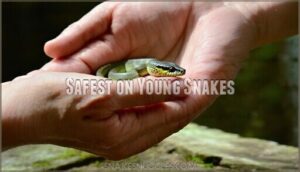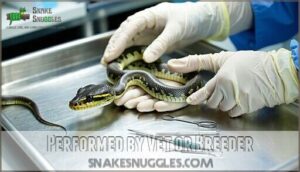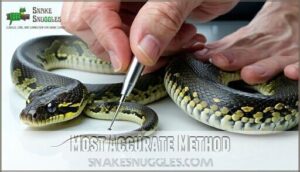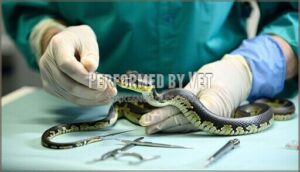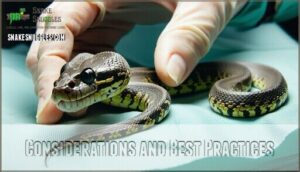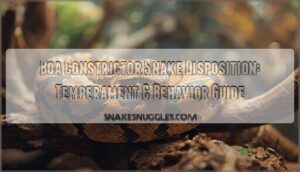This site is supported by our readers. We may earn a commission, at no cost to you, if you purchase through links.

Probing is most accurate but requires experience – you’ll insert a thin probe into the cloaca to measure depth differences between males and females.
Popping works best on very young boas by gently everting male hemipenes.
The "bump test" involves feeling for hemipenes through belly scales, while visual sexing examines tail shape and length.
Baby boas are actually easier to handle than adults, but they’re also more fragile.
Most beginners should leave this task to experienced breeders or veterinarians.
Each technique has specific timing requirements and safety considerations.
Table Of Contents
- Key Takeaways
- How to Sex a Baby Boa Constrictor?
- Sexing Methods for Baby Boas
- Popping Method
- Probing Method
- Considerations and Best Practices
- Other Boa Health Topics
- Frequently Asked Questions (FAQs)
- Does a baby Boa constrict?
- How do boa constrictors give birth?
- Do boa constrictors reproduce sexually?
- How to care for baby boa constrictors?
- Are baby boa constrictors tolerant of handling and socialization?
- How do Baby boa constrictors hatch?
- How to tell if a boa constrictor is male or female?
- How to tell if a baby snake is male or female?
- How to tell if a rosy boa is male or female?
- How fast do baby boa constrictors grow?
- Conclusion
Key Takeaways
- Don’t attempt sexing without professional help – You’ll need an experienced breeder or veterinarian to safely perform probing, popping, or palpation techniques, since improper methods can permanently damage your baby boa’s delicate anatomy.
- Probing offers the highest accuracy – You can achieve near-perfect gender identification when a professional inserts a metal probe into the cloaca, as males allow deeper penetration (9-11 scales) due to their hemipenes, while females only allow 3-4 scales.
- Timing matters for safety – You’ll get the best results when sexing baby boas under six months old, since their underdeveloped muscles can’t resist the techniques like mature snakes, making procedures safer and more accurate.
- Combine multiple methods for confidence – You shouldn’t rely on just one technique, since combining probing with palpation or using the "bump test" alongside visual inspection gives you the most reliable gender determination results.
How to Sex a Baby Boa Constrictor?
Determining your baby boa’s gender requires specialized snake sexing methods that respect Baby Boa Anatomy. Boa constrictor sexing involves three primary techniques: popping snakes, probing snakes, and palpation.
Master the art of boa sexing with safe, proven techniques that protect your serpent’s delicate anatomy.
While sexing baby snake specimens can be tricky, following Ethical Sexing Practices guarantees safety.
Proper handling techniques, such as supporting the body, are vital for minimizing stress during the sexing process.
Professional guidance prevents Beginner Mistakes Avoidance and improves Sexing Accuracy Rates for Hybrid Boa Sexing scenarios.
Sexing Methods for Baby Boas
You can choose from four main methods to determine your baby boa’s gender, each with different safety levels and accuracy rates.
The safest options like palpation work best on young snakes, while more invasive techniques like probing require professional experience to avoid injury.
Popping
Popping snakes involves applying gentle pressure below the cloaca to expose male hemipenes. This snake sexing method works best on babies since their muscles haven’t fully developed yet.
Proper technique requires rolling your thumb toward the vent while supporting the snake. Only experienced breeders should attempt this procedure. Hemipene protrusion confirms the snake is male.
Key popping considerations for sexing baby snakes:
- Snake age matters – safest on hatchlings under six months
- Breeder experience required – improper technique causes hemipene damage
- Popping risks increase with larger boas due to stronger muscles
- Ethical concerns arise when inexperienced handlers attempt the procedure
Probing
While popping works for newborns, probing offers superior accuracy for identifying snake gender in older baby boas.
This snake sexing probe technique involves inserting a sterilized metal probe into the snake cloaca examination area. Safe probing requires proper tool sterilization and gentle handling to prevent avoiding injury during boa constrictor gender determination.
However, it’s important to acknowledge the risks associated with probing, as improper technique can lead to injury.
| Gender | Probe Depth | Hemipene Identification |
|---|---|---|
| Male | 9-11 scales | Reaches inverted hemipene |
| Female | 3-4 scales | Stops at shallow tissue |
Palpation (Bump Test)
The bump test offers impressive accuracy for baby boa constrictor care—98% reliable in snakes under two years old.
This palpation technique involves gently rolling your fingers along the snake’s underside near the tail base.
Males display distinct bumps indicating hemipenes, while females remain smooth.
Safe palpation practices require gentle pressure and experience for proper reptile sex determination through identifying snake gender characteristics.
Visual Sexing
You can try spotting external characteristics like tail length and head shape differences, but visual identification isn’t your most reliable friend here.
Males typically sport longer tails and more arrow-shaped heads, while females grow larger overall.
These coloration clues and scale patterns help with reptile gender identification, though combining methods boosts your confidence in boa constrictor sexing accuracy.
To guarantee successful breeding, females should meet age and size requirements.
Popping Method
You’ll want to avoid popping unless you’re an experienced breeder or veterinarian, as this method can seriously injure your young boa if done incorrectly.
Trust the pros—one wrong move during popping can permanently damage your baby boa’s delicate anatomy.
While popping works best on baby boas under six months old, it requires precise thumb placement and pressure that takes years to master safely.
Safest on Young Snakes
In the context of Early Sexing your baby boa, timing makes all the difference. Juvenile Anatomy works in your favor – young boas haven’t developed the strong muscle control that makes older snakes clamp down defensively.
This Reduced Risk factor makes popping your go-to method for reptile gender identification. You’ll find that Gentle Handling produces the best results with hatchlings and juveniles under two years old.
Their underdeveloped muscles can’t resist the technique like mature boas can. Think of it as the difference between opening a new jar versus one that’s been tightened by a bodybuilder.
For those seeking assistance with the process, consider a boa popping kit. Breeder Expertise becomes invaluable here, as experienced handlers know exactly how much pressure to apply.
The snake sexing probe alternative requires more skill, making Boa constrictor sexing through probing better suited for professionals when dealing with babies.
Performed by Vet or Breeder
Since young boas have underdeveloped muscles, you can’t just wing it with the popping method. This technique demands serious Vet Expertise or Breeder Experience to avoid turning your snake into an expensive vet bill. Training Needed isn’t optional—it’s mandatory for anyone attempting reptile sexing techniques.
Professional veterinarians understand the anatomical nuances that separate success from disaster. They know exactly how much pressure to apply and when to stop.
Here’s why you need a pro:
- Minimizing Harm through proper technique and timing
- Understanding Ethical Concerns around unnecessary stress
- Recognizing when popping isn’t the right choice
- Having backup plans if complications arise
Snakes possess a unique physiology, necessitating specialized veterinary knowledge. Don’t gamble with your boa’s health.
Probing Method
You’ll find probing is the most accurate method for sexing baby boas, but it requires a veterinarian’s expertise to perform safely.
This technique involves inserting a specialized metal probe into the snake’s cloaca, where males will allow deeper insertion due to their hemipene pockets.
Most Accurate Method
Probing stands as the gold standard for snake sex determination, boasting unmatched accuracy when performed correctly.
This method relies on probing depth differences between genders – males accommodate probes 9-11 caudal scales deep due to their hemipenes, while females only allow 3-4 scales of penetration into the cloaca.
Experience matters tremendously here, as proper technique separates reliable results from potentially harmful mistakes. A snake probing kit is essential for this process.
When combining methods like palpation accuracy with probing through method comparison, you’ll achieve near-perfect gender identification. Popping might work for youngsters, but probing delivers consistent, professional-grade results.
Performed by Vet
While probing offers the most accurate snake sex determination, it’s like performing surgery—you need the right hands for the job. Vet expertise makes all the difference in safe sexing and reducing risk of internal damage.
Here’s why professional handling matters:
- Veterinary care providers undergo specialized training in reptile anatomy
- They maintain sterile equipment and proper sanitization protocols
- Their experience guarantees accurate results without harming your baby boa
Unlike popping or palpation, probing requires surgical precision. Access to reptile vet products can further aid in guaranteeing the safety and well-being of your snake during and after the procedure. Trust a professional—your snake’s 25-year lifespan depends on it.
Considerations and Best Practices
You’ll want to approach boa sexing with patience and proper preparation, as rushing through these methods can stress your snake or lead to injuries.
Whether you’re using probing, popping, or palpation, following best practices guarantees both accuracy and your boa’s safety throughout the process.
Use Proper Tools and Ensure Cleanliness
When sexing baby boas, maintaining sterile conditions isn’t just good practice—it’s essential for your snake’s health.
Proper tool sterilization and safe handling techniques prevent infections while ensuring accurate results.
Essential steps for clean sexing procedures:
- Sanitize tools with 70% isopropyl alcohol before and after each use
- Use proper lubrication on snake probes to reduce tissue damage
- Invest in quality snake sexing kits designed specifically for reptiles
- Reduce infections by wearing clean gloves throughout the process
Seek Training From Experienced Handlers or Veterinarians
Looking for expert mentorship in snake sexing? You can’t wing it with baby boas.
Veterinary expertise and professional training prevent costly mistakes.
Experienced handlers teach safe sexing techniques like probing, popping, and palpation.
Their guidance guarantees ethical handling while avoiding injury to delicate snakes.
| Training Source | Benefits |
|---|---|
| Veterinarians | Medical knowledge, injury prevention |
| Experienced Breeders | Hands-on techniques, practical tips |
| Herpetological Societies | Continued learning, networking |
| Professional Workshops | Snake probe usage, proper methods |
Practice on Younger Boas for Safety and Accuracy
After finding an experienced mentor, you’ll want to practice these reptile sexing methods on younger boas.
Here’s why starting with babies makes sense:
- Early Accuracy: Young snakes show clearer anatomical differences for probing, popping, and palpation techniques
- Safer Methods: Baby boas have more flexible tissues, reducing injury risk during bump test procedures
- Reduced Stress: Smaller snakes adapt better to gentle handling during sexing
- Learning Curve: Perfect your technique before tackling adult specimens
The reasons outlined above highlight the importance of starting with younger boas to develop proficiency in reptile sexing methods.
Handle Snakes Gently to Minimize Stress and Defensive Behaviors
Gentle handling is your secret weapon when sexing baby boas.
Move slowly and support their body weight to prevent stress-induced defensive behaviors. A relaxed snake won’t ball up or strike, making examination much easier.
| Stress Signs | Safe Restraint | Handling Benefits |
|---|---|---|
| Rapid breathing | Support body sections | Reduces bite risk |
| Defensive posturing | Avoid sudden movements | Calmer examination |
| Muscle tension | Secure head gently | Better accuracy |
Combine Multiple Methods for Increased Confidence in Gender Determination
You’ll boost your accuracy by combining popping and palpation or probing with bump test methods.
When one technique shows unclear results near the cloaca or hemipenes area, a second method confirms your findings.
Experience matters most – conflicting results happen, but method limitations decrease with practice.
This approach minimizes errors and gives you confidence in determining your baby boa’s gender.
Other Boa Health Topics
Once you’ve mastered sexing your baby boa, you’ll want to keep an eye on their overall health since young snakes can be vulnerable to several common issues.
Understanding these health problems early helps you spot warning signs and keep your boa thriving throughout their long lifespan.
Burns
Burns happen when baby boas get too close to heating elements without proper regulation. Your little serpent can’t tell you "ouch," so burn prevention starts with you.
- Install thermostats: Control heating elements to prevent overheating
- Check enclosure hazards: Remove exposed bulbs or hot surfaces
- Monitor humidity levels: Dry conditions worsen burns
- Apply first aid: Cool water rinse, then veterinary care
Dehydration
Spotting dehydration symptoms early saves your boa’s life.
Low humidity levels and poor water availability cause serious problems.
Watch for wrinkled skin, stuck shed, and sunken eyes.
Maintain 60-70% humidity and provide fresh water weekly.
| Dehydration Signs | Prevention Methods |
|---|---|
| Wrinkled, loose skin | Maintain 60-70% humidity |
| Stuck shed cycles | Provide large water bowl |
| Sunken, dull eyes | Monitor weekly water changes |
Inclusion Body Disease (IBD)
Inclusion Body Disease (IBD) affects boas more than other snakes.
This viral nightmare spreads through contaminated equipment and direct contact between animals.
Watch for these warning signs:
- Stargazing behavior – your boa stares upward constantly
- Chronic regurgitation – food comes back up repeatedly
- Progressive weakness – your snake becomes increasingly lethargic
Unfortunately, there’s no cure for IBD.
Mites
Mites plague boa constrictors like unwelcome houseguests that won’t leave.
These microscopic parasites crawl across your snake’s skin, causing constant irritation around the vent and cloaca areas.
You’ll spot tiny moving specks and notice excessive rubbing behavior.
Quick mite identification prevents infestations from spreading throughout your collection.
| Problem | Solution |
|---|---|
| Mite identification | Check for moving dots on skin |
| Mite treatment | Apply reptile mite spray |
| Enclosure sanitation | Deep clean with disinfectant |
Mouth Rot
Just like mites, mouth rot hits your boa’s health hard. This bacterial infection attacks the mouth and gums, causing serious problems.
You’ll spot pus, swollen gums, and eating troubles. A key preventative measure involves proper boa husbandry.
Here’s what breaks every boa owner’s heart:
- Watching your snake refuse food
- Seeing painful mouth sores develop
- Knowing infection spreads without treatment
Visit your vet immediately for proper Mouth Rot Diagnosis and antibiotic Mouth Rot Treatment.
Frequently Asked Questions (FAQs)
Does a baby Boa constrict?
Yes, baby boa constrictors absolutely constrict prey from birth. You’ll see them wrap around food items like mice or rats, squeezing until the prey stops breathing before swallowing it whole.
How do boa constrictors give birth?
Boa constrictors are ovoviviparous, meaning they give birth to live babies instead of laying eggs.
You’ll see the female deliver fully-formed young after a 100-150 day gestation period following successful mating.
Do boa constrictors reproduce sexually?
Unlike some creatures that clone themselves, these serpents aren’t into solo acts.
Yes, boa constrictors reproduce sexually through internal fertilization.
Males use their hemipenes to transfer sperm to females during mating season.
How to care for baby boa constrictors?
Baby boas need warm temperatures around 80-85°F, high humidity, and appropriately-sized prey every 5-7 days.
Provide secure hiding spots, clean water, and handle gently.
They’re delicate, so avoid overhandling during their first few sheds, and provide high humidity.
Are baby boa constrictors tolerant of handling and socialization?
Young boas can handle brief, gentle sessions but they’re naturally skittish.
Start with 5-10 minute handling periods twice weekly.
Let them settle for a week after bringing them home before attempting any socialization efforts.
How do Baby boa constrictors hatch?
Surprisingly, they don’t actually hatch at all! Your baby boa arrives fully formed since mom’s ovoviviparous – she incubates eggs internally, then delivers live young after 100-150 days of gestation.
How to tell if a boa constrictor is male or female?
You can determine your boa’s sex through probing, palpation, or popping methods.
Probing involves inserting a metal probe into the cloaca – males probe deeper than females due to their hemipenes.
How to tell if a baby snake is male or female?
You’ll need professional help for accurate sexing of baby snakes.
Visual differences aren’t reliable at this age.
Experienced breeders use probing or palpation techniques, but these require training to avoid injury.
How to tell if a rosy boa is male or female?
You can sex a rosy boa using probing, palpation, or popping methods.
Probing involves inserting a metal probe into the cloaca – males probe deeper than females due to hemipene pockets.
How fast do baby boa constrictors grow?
Baby boa constrictors grow rapidly during their first year, gaining 12-18 inches and doubling their weight. You’ll see them reach 3-4 feet by age one, then growth slows substantially.
Conclusion
Surprisingly, learning how to sex a baby boa constrictor becomes much simpler once you understand the four main techniques.
You’ll find that probing offers the highest accuracy, while popping works best on very young snakes.
However, don’t attempt these methods without proper training from experienced handlers or veterinarians.
Your snake’s safety depends on gentle handling and clean tools.
Remember, combining multiple methods increases your confidence in accurate gender determination while keeping your baby boa healthy and stress-free.
- https://www.reptifiles.com/red-tailed-boa-care/sick-boa/burns/
- https://reptilesmagazine.com/tips-for-breeding-boa-constrictors/
- https://virologyj.biomedcentral.com/articles/10.1186/s12985-023-02237-2
- https://oddlycutepets.com/how-to-sex-a-baby-boa-constrictor/
- https://superiormorphs.wordpress.com/2009/04/01/how-to-sex-a-boa/


